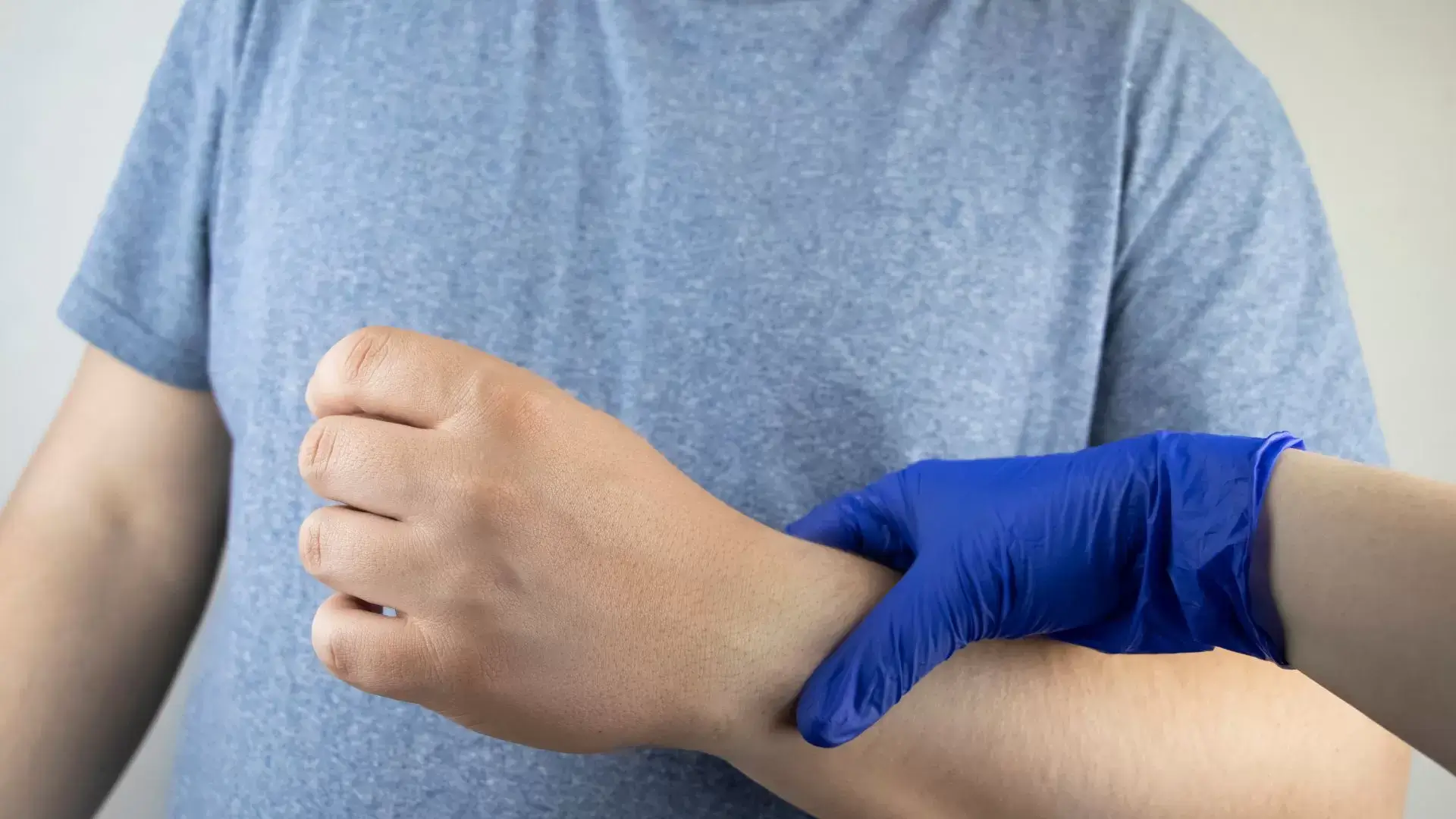When we consider the impact of wrist injuries on daily activities, it’s clear that a thoughtful approach to recovery is essential. Chiropractor for wrist injuries offers specialized care that not only addresses immediate pain but also focuses on long-term wrist health. By understanding the common causes and symptoms of these injuries, we can better appreciate the role of chiropractic assessments and treatments. However, many may not realize the full spectrum of benefits that chiropractic care can provide in this situation. What are some of the specific techniques and strategies that can aid in our recovery journey?

At Physio Chiro Clinic, we specialize in providing extensive physiotherapy and chiropractic services tailored to address wrist injuries and enhance overall recovery. We recognize how debilitating wrist pain can be, whether it’s from a wrist sprain, strain, or repetitive use. Our dedicated team is committed to helping you regain mobility and strength through personalized treatment plans.
Our physiotherapy services focus on wrist rehabilitation, incorporating targeted wrist strengthening exercises and mobility exercises designed to improve function and reduce pain. We assess your specific condition to develop a thorough approach that promotes healing and prevents future injuries.
In addition to physiotherapy, we offer chiropractic care for wrist pain that complements our rehabilitation efforts. Our chiropractors utilize various techniques to alleviate discomfort, improve joint alignment, and enhance overall wrist function.
Chiropractic care plays an essential role in the treatment of wrist injuries, helping to alleviate pain and restore function through targeted adjustments and therapies. We recognize that wrist joint pain can greatly impact daily activities, and addressing it promptly is vital. Our approach often begins with an in-depth wrist pain diagnosis to identify the underlying causes, such as wrist inflammation or chronic wrist pain stemming from repetitive strain injury or wrist overuse syndrome.
Once we’ve pinpointed the issue, we focus on improving wrist mobility issues through tailored wrist physical therapy. This may include specific exercises designed to enhance strength and flexibility, as well as techniques to promote proper ergonomic wrist positioning during work or leisure activities.
In addition, we often recommend wrist support to reduce strain and protect the joints during recovery. By combining these strategies, we aim to not only relieve symptoms but also empower our patients to prevent future injuries. With our extensive care, we’re committed to helping you regain full function and comfort in your wrist, allowing you to return to your daily activities with confidence.
Wrist injuries can stem from a variety of common causes, including repetitive strain from daily activities, sports injuries, and improper ergonomics during work or leisure. Many of us experience wrist trauma due to overuse injuries, which often lead to conditions like wrist swelling, stiffness, and weakness. For example, a sprained wrist can occur when we twist or overstretch the wrist during physical activities, while a fractured wrist can result from falls or direct impacts.
Sports-related wrist injuries are particularly prevalent among athletes, especially those engaged in high-impact or repetitive sports. These injuries can manifest as wrist pain, numbness, or limited mobility, making it essential to address them promptly. Poor ergonomics at our workstations can contribute to wrist issues as well. Prolonged typing or improper wrist positioning can lead to chronic discomfort and pain, emphasizing the importance of wrist pain prevention strategies.
When we experience a wrist injury, it’s important to recognize the symptoms early, as prompt identification can lead to more effective treatment and recovery. Common symptoms we might notice include pain, swelling, and wrist bruising, which could indicate a broken wrist or wrist fracture. Additionally, if we’re experiencing wrist tingling, it may suggest wrist nerve entrapment, requiring immediate attention.
Wrist tendonitis can manifest as discomfort during movement, while wrist instability might present itself through a feeling of looseness or weakness. It’s critical to pay attention to our wrist range of motion; any significant limitations could signal wrist cartilage damage.
In many cases, workplace wrist injuries can develop gradually, often starting with subtle signs that shouldn’t be ignored. If we find ourselves unable to perform tasks without pain or discomfort, it’s important to seek help. Recognizing these symptoms early can be key to preventing further complications and ensuring a smoother path to recovery. By being aware of these signs, we empower ourselves to take proactive steps towards healing.

Accurate diagnosis of wrist injuries hinges on thorough evaluations and appropriate imaging techniques, ensuring we identify the underlying issues effectively. When we examine a patient with acute wrist pain, we begin by conducting a detailed physical examination, evaluating wrist flexibility, strength, and any signs of swelling or tenderness. This initial evaluation helps us determine the potential for conditions like carpal tunnel syndrome or tendonitis.
To confirm our findings, we often recommend imaging studies. A wrist x-ray can reveal fractures or dislocations, while a wrist MRI provides detailed images of soft tissues, helping us identify wrist ligament tears or degenerative joint disease. In some cases, a wrist ultrasound may be utilized to visualize inflammation or evaluate the condition of tendons.
Once we’ve gathered all necessary information, we can develop a tailored treatment plan, which may include wrist instability treatment or rehabilitation exercises. By accurately diagnosing the specific injury, we can address the root cause and facilitate a more effective recovery, allowing our patients to regain their wrist function and improve their quality of life.
Chiropractic adjustments can play an essential role in restoring proper alignment to the wrist joint, promoting healing and improving overall function. We recognize that wrist dysfunction can stem from various issues, including wrist tendon rupture or median nerve compression. By addressing these misalignments, chiropractic care helps alleviate pain and enhances mobility.
In addition to adjustments, we often recommend complementary techniques like wrist bracing and ice therapy. These methods support the healing process by reducing inflammation and providing stability to the injured area. As we collaborate, incorporating physiotherapy for wrist injury, such as wrist stretching exercises and compression, can further aid in recovery.
For patients facing more severe injuries, like those requiring wrist ligament reconstruction or even wrist surgery, our adjustments can be beneficial in post-operative rehabilitation. They help realign the joint, facilitating smoother recovery and improved function.
Ultimately, our goal is to provide a holistic approach to wrist health, combining chiropractic adjustments with supportive therapies to guarantee you regain peak wrist function and quality of life. Together, we can navigate the path to recovery, addressing any challenges along the way.
Soft tissue therapy can greatly enhance wrist pain relief by targeting the muscles, tendons, and ligaments surrounding the joint to reduce tension and promote healing. Whether we’re dealing with wrist arthritis, such as osteoarthritis of the wrist, or conditions like de Quervain’s tenosynovitis, our goal is to restore function and alleviate discomfort.
Utilizing techniques like deep tissue massage and myofascial release, we can effectively address issues related to wrist dislocation, wrist impingement, or even a triangular fibrocartilage complex (TFCC) tear. These therapies help improve circulation and flexibility, which are essential for recovery, especially after wrist hyperextension injuries.
For those managing ganglion cysts or recovering from post-surgical wrist rehab, incorporating wrist heat therapy can further enhance the relief we seek. By focusing on the soft tissues, we aim to reduce inflammation and promote an overall sense of well-being. Together, we can create a personalized approach to wrist pain relief, ensuring that each treatment aligns with our individual needs and goals. Our commitment is to support you in achieving ideal wrist health and functionality.
After addressing soft tissue concerns, it’s important to recognize how we can effectively treat sprains, strains, and ligament injuries to restore wrist function and alleviate pain. These types of wrist injuries often result from repetitive motions or acute trauma, leading to discomfort and decreased mobility.
We employ various techniques, such as wrist taping, to provide support and reduce strain on injured ligaments. For conditions like de Quervain’s tenosynovitis or ulnar nerve compression, targeted adjustments can help alleviate pressure and improve overall function.
In cases of more severe injuries, such as a scaphoid fracture or rheumatoid arthritis of the wrist, we may recommend additional interventions, including wrist cortisone injections to manage inflammation and pain.
Our approach is thorough, focusing not only on immediate relief but also on long-term recovery strategies. By working together, we can develop a tailored treatment plan that addresses the unique aspects of each wrist injury, ensuring a smoother path to healing and effective wrist function. We’re committed to helping you regain strength and mobility, allowing you to return to your daily activities without discomfort.

Carpal tunnel syndrome can be a frustrating condition, but with the right chiropractic techniques, we can help alleviate discomfort and restore function in the wrist and hand. At our clinic located at 123 ABC Road, Oakville, Ontario, we focus on identifying the underlying causes of your symptoms, such as wrist hyperflexion or conditions like De Quervain’s tenosynovitis.
We utilize a combination of adjustments and soft tissue therapies aimed at relieving pressure on the median nerve. By gently mobilizing the wrist and improving alignment, we can enhance circulation and reduce inflammation. It is crucial to address any related issues, including potential lunate dislocation, to achieve ideal results.
Our approach also emphasizes education. We’ll guide you through exercises and ergonomic adjustments to minimize stress on your wrist during daily activities. If you’re experiencing symptoms like tingling, numbness, or weakness, we encourage you to reach out. We’re here to support you on your path to recovery. For more information, don’t hesitate to call us at 111-111-1111. Together, we can take the necessary steps towards relieving your carpal tunnel syndrome.
Many individuals who experience carpal tunnel syndrome may also suffer from repetitive strain and overuse injuries, which can complicate their recovery and overall wrist function. These injuries often arise from repetitive motions, poor ergonomics, or prolonged activities that stress the wrist. As chiropractors, we recognize how these factors can lead to discomfort, reduced mobility, and decreased quality of life.
Chiropractic care can play an essential role in addressing these issues. By focusing on spinal alignment and joint function, we aim to relieve pressure on the nerves and improve blood flow to the affected areas. Techniques such as gentle adjustments and myofascial release can help restore balance and alleviate pain, allowing for better wrist function.
We also emphasize the importance of education in our approach. By providing insights into proper ergonomics and activity modifications, we empower our patients to make informed decisions that can help prevent further injury. Ultimately, our goal is to support individuals in their recovery journey, fostering a more efficient healing process while enhancing overall wrist health. Through chiropractic care, we believe many can regain their strength and functionality, allowing them to return to their daily activities with confidence.
Recognizing the importance of strengthening and mobility exercises, we can greatly enhance wrist rehabilitation and support recovery from injuries. These exercises play a critical role in restoring function, reducing pain, and preventing future issues. We should begin with gentle mobility exercises to improve range of motion, such as wrist circles and flexion and extension stretches. These movements help maintain joint flexibility and reduce stiffness.
As our wrist begins to feel more comfortable, we can gradually incorporate strengthening exercises. Simple activities like squeezing a stress ball or using a light resistance band can effectively build strength in the wrist muscles. It is vital to focus on proper form and avoid any movements that cause pain.
Incorporating these exercises into our daily routine not only aids recovery but also promotes overall wrist health. We recommend starting with a few minutes each day, progressively increasing intensity as our strength improves. Consistency is key in this process, and we should listen to our bodies, adjusting our exercises as needed. By committing to these strengthening and mobility exercises, we can foster a more resilient wrist, ultimately enhancing our quality of life.
Implementing ergonomic modifications and making postural corrections are vital steps we can take to protect our wrist health, especially during daily activities that involve repetitive motions. By evaluating our workstations and the tools we use, we can create a more supportive environment for our wrists.
First, we should verify our keyboards and mice are positioned at elbow height, allowing our wrists to remain in a neutral position. Using wrist supports can also help reduce strain during prolonged computer use. We can benefit from taking regular breaks to stretch and reposition ourselves, alleviating tension that builds up over time.
In addition to our work environment, let’s pay attention to our overall posture. Sitting up straight with our shoulders relaxed and our feet flat on the ground helps maintain proper alignment, reducing unnecessary stress on our wrists. When we engage in activities like typing or texting, it’s vital to keep our wrists straight instead of bending them at awkward angles.
How can chiropractic support aid in managing arthritis and degenerative conditions of the wrist? We realize that arthritis and degenerative conditions can greatly impact our quality of life, causing pain and limiting mobility. Chiropractic care offers a holistic approach to addressing these issues. By focusing on spinal alignment and joint function, we can help improve overall wrist health.
Chiropractors utilize various techniques, such as adjustments and mobilization, to alleviate discomfort and enhance joint function. These methods aim to reduce inflammation, increase circulation, and promote healing within the affected areas. We’re committed to developing individualized treatment plans that take into account each person’s unique condition and lifestyle.
Additionally, we often incorporate exercises and stretches into our care plans, which can strengthen the muscles surrounding the wrist and improve flexibility. This proactive approach not only helps alleviate current symptoms but also aims to prevent further deterioration of the condition.
Cold and heat therapy can be effective tools in managing wrist pain, as they help to reduce inflammation and promote blood flow, ultimately aiding in the healing process. When we apply cold therapy, such as ice packs or cold compresses, we constrict blood vessels, which can alleviate swelling and numb the affected area. This method is particularly beneficial right after an injury or during flare-ups.
On the other hand, heat therapy, which includes warm towels or heating pads, helps to increase circulation and relax tense muscles. This can be especially useful for chronic pain or stiffness, as it encourages blood flow and promotes healing.
We often recommend alternating between cold and heat therapies. This combination can maximize the benefits, allowing us to tackle pain from multiple angles. It’s important to remember, however, to apply these therapies in moderation—15 to 20 minutes at a time, ensuring we protect our skin from potential damage.
Ultimately, incorporating cold and heat therapy into our pain management routine can greatly enhance our comfort and mobility, paving the way for a more effective recovery.
Regular chiropractic wellness care can play an essential role in preventing future wrist injuries by addressing misalignments and improving overall joint function. When we visit a chiropractor, we’re not just treating existing issues; we’re proactively enhancing our body’s resilience against potential injuries.
Chiropractic adjustments help realign the wrist and surrounding joints, reducing stress and strain on the muscles and ligaments. By optimizing our joint function, we create a more balanced musculoskeletal system that can better handle the demands of daily activities, whether it’s typing at a computer or engaging in sports.
Additionally, chiropractors often provide personalized exercise programs and ergonomic advice that empower us to strengthen our wrists and improve flexibility. These tailored strategies can considerably lower our risk of re-injury.
Moreover, regular check-ups allow us to identify any emerging issues before they escalate into more serious problems. By committing to consistent chiropractic care, we cultivate a holistic approach to wellness that prioritizes prevention. Together, we can work toward maintaining healthy wrists and overall well-being, ensuring that we stay active and pain-free in our daily lives.
Scheduling a chiropractic consultation for wrist injury treatment can be a vital step toward recovery and regaining full functionality. We acknowledge how debilitating wrist pain can be, affecting daily activities and overall quality of life. By reaching out to a chiropractor, we can begin the journey to healing, as they specialize in evaluating and treating musculoskeletal injuries.
During our consultation, the chiropractor will conduct a thorough evaluation of our wrist, checking for any misalignments, soft tissue damage, or underlying issues. They’ll take the time to listen to our concerns, comprehend our symptoms, and develop a tailored treatment plan that addresses our specific needs. This may include spinal adjustments, soft tissue therapy, and rehabilitation exercises to strengthen the wrist and improve mobility.
We should remember that early intervention is key. By scheduling our appointment promptly, we can minimize the risk of long-term complications and guarantee a smoother recovery process. Our chiropractor will guide us every step of the way, helping us regain strength and flexibility in our wrist. Let’s take this proactive step together, prioritizing our health and well-being as we work toward a pain-free future.
When we’re dealing with a wrist injury, recovery time can vary considerably based on the severity and type of injury. Generally, we might see improvement within a few weeks to several months. It’s important to listen to our bodies and follow a proper rehabilitation plan. By being patient and consistent with our recovery efforts, we can help guarantee a more effective healing process and minimize the risk of future issues.
When it comes to chiropractic treatments for children, we should always prioritize safety and well-being. Generally, chiropractic care can be safe for kids, especially when it’s tailored to their specific needs. However, it’s essential to consult with a qualified professional who has experience working with children. We must guarantee that any treatment plan is appropriate and addresses the child’s unique circumstances, promoting healing while minimizing any potential risks.
When considering whether we can continue our sports activities during chiropractic treatment, it’s crucial to consult our chiropractor first. They’ll assess our specific situation and advise us based on our condition. Generally, moderate activity might be encouraged to maintain strength and flexibility, but high-impact sports could exacerbate our issues. We should listen to our bodies and communicate openly with our chiropractor to guarantee we’re making the best decisions for our recovery.
During our first chiropractic appointment, we can expect a thorough consultation and assessment. The chiropractor will ask about our medical history, symptoms, and lifestyle. Then, they’ll perform a physical examination, which might include postural analysis and movement tests. We should feel comfortable discussing our concerns, as they aim to create a personalized treatment plan. It’s an opportunity for us to ask questions and understand how chiropractic care can benefit our overall well-being.
When it comes to seeing a chiropractor, we often wonder if a referral is necessary. Generally, we don’t need a referral to schedule an appointment, as many chiropractors accept patients directly. However, it’s wise to check with our insurance provider, as some plans might have specific requirements. By understanding our options, we can make informed decisions about our care and guarantee we receive the treatment we need without unnecessary delays.
Reach out to us today to book an appointment or learn more about our services. Our friendly team is here to answer your questions and help you take the first step toward improved health and wellness.
(647) 372-1209

At our Physio-Chiro Clinic, we are dedicated to providing personalized care that addresses the root cause of your discomfort. With a team of experienced physiotherapists and chiropractors, we focus on restoring your mobility, relieving pain, and enhancing your overall well-being.